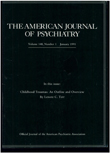High prevalence of obsessive-compulsive symptoms in patients with Sydenham's chorea
Abstract
The 20-item Leyton Obsessional Inventory--Child Version was completed by children and adolescents who had had Sydenham's chorea (N = 23) or rheumatic fever without chorea (N = 14). The Sydenham's chorea subjects had significantly more obsessive thoughts and compulsive behaviors and significantly greater interference from these behaviors. Three Sydenham's chorea patients but no rheumatic fever patients had substantial obsessional interference and met criteria for obsessive- compulsive disorder when interviewed by telephone. This suggests that obsessive-compulsive disorder, at least in some patients, may be due to basal ganglia dysfunction.
Access content
To read the fulltext, please use one of the options below to sign in or purchase access.- Personal login
- Institutional Login
- Sign in via OpenAthens
- Register for access
-
Please login/register if you wish to pair your device and check access availability.
Not a subscriber?
PsychiatryOnline subscription options offer access to the DSM-5 library, books, journals, CME, and patient resources. This all-in-one virtual library provides psychiatrists and mental health professionals with key resources for diagnosis, treatment, research, and professional development.
Need more help? PsychiatryOnline Customer Service may be reached by emailing [email protected] or by calling 800-368-5777 (in the U.S.) or 703-907-7322 (outside the U.S.).



